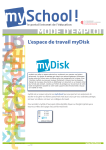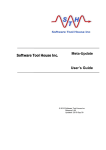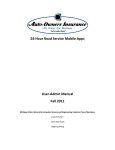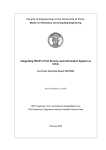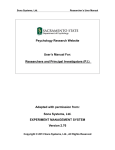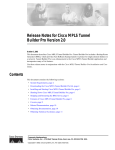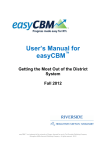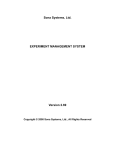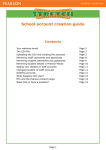Download How to Upgrade Open Admin for Schools
Transcript
Open Administration for Schools 4.75
Administrator Documentation
Les Richardson
July, 2010
Contents
Installation
Overview for Newbies . . . . . . . . . . . . . . . . . . . . . . . . .
File Locations . . . . . . . . . . . . . . . . . . . . . . . . . .
Program Requirements . . . . . . . . . . . . . . . . . . . . . . . .
Installation Overview . . . . . . . . . . . . . . . . . . . . . . . . .
Step 1: Install Linux . . . . . . . . . . . . . . . . . . . . . .
Step 2: Copy the Files . . . . . . . . . . . . . . . . . . . . . .
Step 3: Configure the Webserver . . . . . . . . . . . . . . .
Step 4: Set up MySQL . . . . . . . . . . . . . . . . . . . . .
Step 5: Converting Student Data . . . . . . . . . . . . . . .
Step 6: Configuration . . . . . . . . . . . . . . . . . . . . . .
Step 7: Getting Started on the Browser Side... . . . . . . .
Install Appendix A - Setting up the PostgreSQL Database
Install Appendix B - Setting Up Webname Resolution . . .
.
.
.
.
.
.
.
.
.
.
.
.
.
.
.
.
.
.
.
.
.
.
.
.
.
.
.
.
.
.
.
.
.
.
.
.
.
.
.
.
.
.
.
.
.
.
.
.
.
.
.
.
.
.
.
.
.
.
.
.
.
.
.
.
.
.
.
.
.
.
.
.
.
.
.
.
.
.
.
.
.
.
.
.
.
.
.
.
.
.
.
.
.
.
.
.
.
.
.
.
.
.
.
.
.
.
.
.
.
.
.
.
.
.
.
.
.
.
.
.
.
.
.
.
.
.
.
.
.
.
.
.
.
.
.
.
.
.
.
.
.
.
.
.
.
.
.
.
.
.
.
.
.
.
.
.
.
.
.
.
.
.
.
.
.
.
.
.
.
3
3
3
4
6
6
7
9
12
14
14
23
25
26
How to Upgrade Open Admin for Schools
28
Versions . . . . . . . . . . . . . . . . . . . . . . . . . . . . . . . . . . . . . . . . . . . . . . 28
Model OpenAdmin Installation - Single Site with SSL
30
Customize OA - Adding New Fields to Students and Staff
40
Overview . . . . . . . . . . . . . . . . . . . . . . . . . . . . . . . . . . . . . . . . . . . . . 40
Extending Student Demographics . . . . . . . . . . . . . . . . . . . . . . . . . . . . . . 40
Security
43
Web Security . . . . . . . . . . . . . . . . . . . . . . . . . . . . . . . . . . . . . . . . . . . 43
External User Management
44
Add External Server User Accounts . . . . . . . . . . . . . . . . . . . . . . . . . . . . . 44
LDAP - Directory Management
46
LDAP Scripts . . . . . . . . . . . . . . . . . . . . . . . . . . . . . . . . . . . . . . . . . . 46
1
LDAP - Installation
47
Installation . . . . . . . . . . . . . . . . . . . . . . . . . . . . . . . . . . . . . . . . . . . . 47
Maintenance
50
Multiple Servers . . . . . . . . . . . . . . . . . . . . . . . . . . . . . . . . . . . . . . . . . 50
Ubuntu 10.04 Server Install
2
51
Installation
Version Information
• OA 4.75 – July 2010
• OA 3.50 – December 2008
• OA 3.25 – August 2008
• OA 2.50 – December, 2007 - new SSL single site instructions based on Debian/Ubuntu
by Andy Figueroa. Other directions updated to match. (older entries removed)
Please read this over before trying to do too much!
Overview for Newbies
Each school that is running Open Admin could normally have up to three virtual websites...one
for the school office, one for teachers, and one for parents/students.
An installation capable of running on a single SSL (or not) protected website is also available.
The html and cgi scripts for all sites for each school are located in a common folder, normally
under the school name. /opt/openadmin/YOURSCHOOL.
The administration or office site has it’s files in admin for the HTML files and cgi for the
matching cgi scripts. Similarly the teacher site directories are called tadmin and tcgi. So
also, phtml and pcgi for the parent site.
If you are limited to having one site only (as some Australian schools are), it can also be
configured to run on this single site.
File Locations
Everything is arranged like this ( /opt/openadmin can be replaced with another file path on
your server):
/opt/openadmin/stpeter/admin – for St Peter School main admin site
/opt/openadmin/stpeter/cgi
/opt/openadmin/stpeter/tadmin – for St Peter School teacher site
/opt/openadmin/stpeter/tcgi
/opt/openadmin/stpeter/padmin – for St Peter School parent site
/opt/openadmin/stpeter/pcgi
As well as these 6 folders, there are 3 additional folders for:
• Configuration - these values are stored in the etc folder.
3
• Templates - these templates for reports and editing are stored in the templates folder.
• Libraries - function libraries used by scripts in cgi, tcgi, and pcgi are located in lib.
Together, these 9 folders make up the Open Admin files for a school.
There is also a global.conf configuration file listing all of the schools in a school division,
consortium, etc. if more than one installation. If not, then only the version of this file found
in the school’s etc directory need be used.
If more than one school installation is done, the global.conf file should be placed in
/opt/openadmin/global
so that all school installations may read it, and share data. This is so that withdrawn students
from one school can be easily enrolled in another (ie. feeder schools). Even single schools have
to add their database name to this file. This is one of the installation problems people have
had in the past. The location of this directory in set in the admin.conf file and would normally
be your schools etc folder by default.
If you are running the IEP (Special Education) site, you can install those files in:
/opt/openadmin/iep/admin – for the special needs website.
/opt/openadmin/iep/cgi
Program Requirements
One of the design goals of OA was to make it relatively easy to install and lightweight to run
both in hardware and bandwidth demands so that even satellite connections with long latency
will work. This has already been demonstrated in many remote schools.
• A webserver supporting virtual hosting and/or SSL (for encrypted communcation over
the Internet). This is normally the freely available Open Source Apache web server
software.
• A Perl interpreter; a recent version would probably be good. The 5.10 release is current.
• MySQL or PosgreSQL - freely available SQL databases. For MySQL, a 5.x version should
be used. One should be conservative in the use of bleeding edge software for a database.
The current Open Admin release supports MySQL 5.x (with new reserved words). Use
the appropriate blank.sql database from the utility/sql folder of the download to populate
it for a new installation.
For PostgreSQL, a new stable version should be used. However, Pg has not been used
for a couple of years in normal testing.
• A standard TeX installation including pdflatex ( normally installed with Linux distributions). The new TeX Live installation should be used, if possible. It should be installed
using your Linux distro packaging. If not included with your distribution of Linux, then
look at tug.org (TeX User Group). This will run on all Unix-like Operating systems
(including Mac OSX) and also on MS Windows servers.
4
• Accessory utility software. The student image management functions will require an
ImageMagick installation ( for the convert program to convert image sizes.
• LibXML2 (from www.xmlsoft.org) - an XML library in C. This is required to parse the
FET scheduler teacher xml file to import your timetable into OA. If not using the FET
scheduler (and not a Saskatchewan school using the SDS system), you do not need this
xml parser, currently. This will likely change as new reporting functions require xml
markup.
The following perl modules will also be required:
• CGI
• DBI ( and the DBD drivers to connect to MySQL or Pg )
• Text::CSV XS - for conversion to/from CSV format.
• XML::LibXML - a perl module that uses LibXML2 library (if using XML).
• Date::Business - for date functions such as attendance reports.
• Time::JulianDay - other date calculations
• FreezeThaw (install this before CGI::Session since it is required by CGI::Session ).
• CGI::Session - session management for the teacher site.
• Data::Password - used for checking staff passwords for security.
• Crypt::GeneratePassword - used to generate staff passwords when adding new staff.
• Number::Format - a rounding function used in place of sprintf.
In order to install the perl modules, the easiest approach is to use the packages and package
manager that comes with your Linux version. The Debian / Ubuntu package manager (aptget) makes this fairly straight forward. More is found under the Debian/Ubuntu installation.
Another method is the CPAN method. The CPAN (Comprehensive Perl Archive Network) is
a worldwide network of servers from which you can automaticallY download and install the
modules. The first time this is used you configure the server locations you want to use, etc.
The defaults suggested work fine.
One syntax is as follows:
perl -MCPAN -e ’install PERLMODULE’
where PERLMODULE is the name of the module to install... such as FreezeThaw. Case
appears to be an issue. If you can’t find the right name go to the CPAN search site
( http://search.cpan.org ) and have a look around.
5
If you are using the software in Saskatchewan and would like to communicate directly to the
provincial SDS system, then additional software and perl modules are required since we create a secure HTTPS connection to the Sask Learning server and send and receive transactions
in an XML format.
You will also need:
1. OpenSSL (from www.openssl.org) - SSL library required for https.
2. Perl Modules:
(a) Bundle::LWP (which includes LWP::UserAgent, HTTP::Headers, and
HTTP::Request::Common) - used to connect via https.
(b) Crypt::SSLeay (for SSL connections)
(c) XML::Writer - used to write the output XML.
(d) XML::Writer::String - holds xml output in a string.
(e) Data::UUID
GD Graphics for the Reading Report Graphs from libgd.org. Then the supporting perl
modules: GD::Graph. We also need zlib and libjpg and also libpng if you’d like.
Installation Overview
The installation process consists of the following steps:
1. Install Linux
2. Copy the files.
3. Configure the Webserver.
4. Add the Data to the database.
5. Import Student Data.
6. Edit the Configuration.
7. Get Started (on the Browser Side)
Step 1: Install Linux
Download the latest Ubuntu Server or Debian Installation (or your Linux distribution of
choice). Make sure that you add Apache, Perl, MySql (or PosgreSQL), and TeXLive. Please
see the Ubuntu/Debian Installation instructions.
If creating an Open Admin only server, then a minimal, lightweight installation would be a
good choice. The idea is to create a server appliance that needs only minimal, if any, management. As well, only a minimal hardware platform will be required if only a few schools are
running on it.
6
Step 2: Copy the Files
1. Download the latest Open Admin version from http://richtech.ca/openadmin into /tmp (or
some other commonly used file location). If you download to your workstation desktop
you can copy to your server using a secure copy program like scp, or simply copy it to a
flash drive and copy onto the server in this way.
2. Untar the download:
tar xvzf openadmin-4.xx.tgz
This will create /tmp/openadmin-4.xx with:
• /tmp/openadmin-4.xx/school - containing the main files required for each school site
• /tmp/openadmin-4.xx/utility - contains files needed for installation. These first 2
are the main directories needed for installation.
• /tmp/openadmin-4.xx/iep - contains the IEP special education website application.
This is the IEP site. It contains a cgi folder for the perl scripts and a www folder for
the html files.
• /tmp/openadmin-3.xx/docs - contains a Readme file telling where real docs are found.
Also contains the Gnu GPL license file.
• /tmp/openadmin-3.xx/sis - Contains a central office application to see all school enrollments, search for students in all schools, ethnic enrollments, and also Google
App / Gmail controls for external servers.
3. Create a directory to hold the files for a school (or several) if it doesn’t already exist.
mkdir /opt/openadmin
We will assume that you are using /opt/openadmin. Just substitute another filepath.(ie.
/opt, /Library/Webserver/ if OSX, etc.)
4. Copy the directory containing the main OA school site files into this new directory with
a short single word for the school:
cp -r /tmp/openadmin-3.xx/school /opt/openadmin/stpeter
where stpeter is replaced with your school name. (if it’s not St. Peter!) You now
have the main school files in place to run the 3 main St. Peter websites (main, teacher,
parent).
5. Copy the school folder as many times as required to get one school folder for each school.
(ie. cp -r /tmp/openadmin-4.xx/school /opt/openadmin/stmary )
This assumes a multi-school installation. Just do this once if a single school.
6. Check/change the ownership and permissions on the files/folders. The files in the downloaded tar distribution are set to root ownership and members of root group.
Change the ownership of the copied files/directories to that of the user and group that
the webserver runs as. In Debian/Ubuntu this is www-data for both user and group. For
Slackware this is webuser and webgroup. For Red Hat this is apache for both. Make
7
sure that you are in the /opt/openadmin directory so that you change the ownership of
everything below this level in the filesystem.
If www-data:www-data then chown -R www-data:www-data *
If apache:apache then: chown -R apache:apache *
If this seems too loose in terms of security ( since you may have users on this system),
ownership may be left at root/root for scripts and just make sure that the running scripts
can create required LaTeX files in the folder where the script runs that is creating it. If
not set correctly, you’ll see entries in the error log about the script not being able to
create tex files and no pdf files (such as student roster reports and report cards) will be
created. Get into the habit of checking the webserver logs for each of the sites. Again,
the location of these log files varies depending on the linux distribution that you are
using. On Debian/Ubuntu servers, it is located in /var/log/apache2 while Red Hat
stores them in /var/log/httpd.
A running script must also be able to copy generated PDF files into the download folder
in admin or tadmin of the main or teacher site. Scripts must also be able to change the
term file, studentnumber, receiptnumber files in the school level etc folder as well. You
will have to change the permissions on these files and directories if you don’t reset the
ownership to that of the User Id (UID) that the webserver runs as (as outlined above).
7. Copy your School Logo file (if you have one) into the school directory admin/images.
For example, /opt/openadmin/stpeter/admin/images folder and name it logo.gif.
It should already be in GIF format! You should replace/erase the existing files (logo.gif
and logotn.gif).
The size of your logo.gif should be approximately 150-200 pixels high or so (and a reasonable width). Excessive width (more than 300 pixels or so) may cause layout problems
on smaller screens. Pick a size that is pleasing when displayed on the main page. This
should give a good starting point. A smaller version of the school logo (about 100 pixels
high) should be saved and renamed to logotn.gif (Logo Thumbnail) This is the logo visible on the attendance, discipline, report card pages, etc. To conserve bandwidth, these
should be as small as possible. The other 2 small image files tabactive.gif, tabmain.gif
(total 2k in size) implement the menu system on the admin site.
8. Edit the configuration file called admin.conf located in the school etc directory. For
example, (/opt/openadmin/stpeter/etc) This is read by all of the scripts (cgi, tcgi,
pcgi) and is required to access the database, put in the right navigational links, etc.
Three important entries of the admin.conf configuration file are for user, database, and
password. The user and password would be set when installing the database. More on
this below. The fourth entry, dbtype selects whether you are using MySQL(mysql) or
PosgreSQL (Pg). The rest of the entries in this file should be obvious from the comments
around them. More on this below, also.
There is also a file called studentnumber located in the school etc folder that stores the
next available student number. This should be set once students have been imported
into this system. It stores the next available student number. For small standalone
schools, a 3 digit starting number would be a good choice (ie. 100). This is the default.
8
Other files in this folder... term, receiptnumber must also be writeable by the webserver
user.
If you are installing multiple copies of openadmin for division schools, then blocks of
numbers should be set aside for each school. There is currently no checking for overlap
of numbers, so give each lots of room. This will give a unique student number to each
student in the division, thus enabling easy data transfers and enabling use of the shared
IEP system (which require unique student numbers for all students in that system and
still requiring access back to their home school database).
Make sure that the download folders in admin and tadmin for each school are writeable by the webserver user (the user the webserver runs as) so that scripts, which run
with the same UID, can place created files there for downloading (mentioned above). A
background script running daily (ie. a cron job) should be set to empty out these folders.
Step 3: Configure the Webserver
These are directions to set up the Apache webserver. If using other webserver software, you’re
on your own. Look for the virtual website documentation for that server. ( It should have name
based virtual site capability rather than IP based virtual sites, although either method could
be used. )
There are several basic variations on configuration depending on your version of Linux:
1. Debian / Ubuntu – In these distros the Apache configuration files are located in /etc/apache2.
In the utility folder of your download, there is a file called apache2-debian.conf. Edit
this file and search and replace the ’SCHOOLNAME’ text into the folder name of your
school (ie. stpeter). As well, change the ServerName entries to the domain names for
your websites. This should provide a good starting point for your school sites.
Copy and Rename this file into /etc/apache2/ sites-available. Then create a symbolic link
in the /etc/apache/sites-enabled folder to point to this file. Alternatively, just copy the
file directly into sites-enabled.
2. Red Hat and Friends – In these distros the Apache configuration files are located in
/etc/httpd.
In the utility folder of your download, there is a file called apache2-redhat.conf. Edit
this file and search and replace the ’SCHOOLNAME’ text into the folder name of your
school (ie. stpeter). As well, change the ServerName entries to the domain names for
your websites. This should provide a good starting point for your school sites.
Copy this file into /etc/httpd/conf and rename it with a school name (ie. stpeter.conf).
Then edit the httpd.conf file in the same folder. At the bottom of the file (where Virtual Sites are normally configured), add a line: Include conf/stpeter.conf where
stpeter.conf is the name of the file renamed above. The text NameVirtualHost *:80
should also be added above the Include (if not present somewhere above the Include
line). This turns on virtual hosting.
3. Other Distros – More General Instructions
9
The webserver settings are located in a file called httpd.conf. This file is normally
located in the server’s, etc/apache2 or /etc/httpd directories.
The virtual websites are normally at the bottom of this file. External config files are
the easiest way to configure OA, and can be pulled in with include statements in the
httpd.conf. It would look like:
NameVirtualHost *:80
Include conf/myhttpd-school.conf
Include conf/another-school.conf
The NameVirtualHost directive turns on name based virtual hosting so that web browsers
can send a site name in an http header and the webserver will provide a site based on
that name.
The conf folder in the Include statement is added since the include file is located relative
to DocumentRoot, described below). Examples of this external file is found in the utility
directory and are called apache2-xxxx.conf).
Here is an example of an apache2-*.conf include file for St Peter School. It assumes that
the NameVirtualHost *:80 has been placed in the main httpd.conf file before the Include
statement that loads this school configuration file. It also includes teacher authentication from staff table rather than file.
# Start of Admin Site
<VirtualHost *:80>
ServerAdmin root@localhost
DocumentRoot /opt/openadmin/stpeter/admin
ServerName stpeter-admin.mysd.ca
# Make .shtml files be parsed
AddType text/html .shtml
AddHandler server-parsed .shtml
DirectoryIndex index.shtml
ErrorLog /var/log/httpd/spa-error-log
CustomLog /var/log/httpd/spa-access-log common
ScriptAlias /cgi-bin/ "/opt/openadmin/stpeter/cgi/"
<Directory /opt/openadmin/stpeter/admin>
Options +Includes # turns on Server Side Includes (SSI)
# to parse date (and user in teacher)
AuthType Basic
AuthName Admin
AuthUserFile /etc/httpd/auth_users/stpeteradmin
<Limit GET POST>
require valid-user
</Limit>
</Directory>
10
<Directory /opt/openadmin/stpeter/cgi>
AuthType Basic
AuthName Admin
AuthUserFile /etc/httpd/auth_users/stpeteradmin
<Limit GET POST>
require valid-user
</Limit>
</Directory>
</VirtualHost>
Some key points being:
DocumentRoot: The path to your html files for this virtual site.
ServerName: the name the virtual site should be identified as.
ScriptAlias: where your perl (.pl) scripts are located for this site.
The server side includes are turned on to process the main admin .shtml file so that it
will corrrectly display the current date. This is done above with the ”Options +Includes”.
This is also true of the teacher site to allow the Apache user to be seen.
You can test this configuration with the Apache controller.
apache2ctl configtest
You may have to include it’s full path, typically /usr/sbin/apachectl. It should respond
with an OK. If not, fix the problem and try again. If all is well, then you may restart the
web server. One method is:
apache2ctl graceful
Setup Access Control
There are 2 methods to control access to these sites:
1. File Access Control - files contain userid and password information that control access
to particular site.
The password file(s) that control access to the virtual site(s) are created using the htpasswd program. Currently this is only the main admin site since the teacher site can
be configured to use the values in the staff table for authentication / authorization.
A folder named auth users must be created in /etc/httpd or /etc/apache2 (if it doesn’t already exist) and the htpasswd program used to create entries in the auth users/stpeteradmin
file. Only these users will have access to the admin site. Normally only a few passwords
are used for these sites. Read the man page for htpasswd program to see how to do this.
The teacher site normally uses database authentication, but a file based authentication
like the main admin site may be used also.
2. Mysql Access Control - user information is read from the staff table. The file called
apache2-teacherauth.conf in the utility folder contains the directory commands
11
that may be copied in place of the teacher site directory commands in your school.conf
( stpeter.conf ) file. This will allow teachers to log into the teacher site using their own
userid and password. The mod auth mysql module will also have to be installed and
working in your Apache installation, if not already installed.
Setup Log Files
Next are the log files which record site activity. The log files are very important to signal any
problems or errors. In the event of white screens with nothing on them (Secretaries notice
things like this... I call them WSOD... White Screens of Death),
Look at the Log Files!
Normally we create a /logs symbolic link to point to where the log files are actually located
(ie. /var/log/apache2/). This simplifies the query for problems:
tail /logs/stpetera-error.log – view main site error log.
Also note, that if doing updates, you can use symbolic links in Linux filesystems (Windows
NTFS filesystems have limited symbolic link support, as far as I know. This would allow you
to install an updated version of OA in a different folder and then use a symbolic link to point
to this new folder, rather than another older folder. If you have installation problems (and
your site is very active, as it normally is with school admin), you can quickly switch back to
older code (as long as the table structures haven’t changed with the newer version).
These directions assume that Apache has it’s configuration installed in /etc/httpd or etc/apache2.
These are the normal locations for most Unixlike operating systems.
Step 4: Set up MySQL
See the Installation Appendix for the PostgreSQL instructions if using that database engine.
I will assume that you have a basic installation of MySQL and that the MySQL engine is
running. (If you’re not sure, do a ps aux and you should see several mysql processes running).
Normal installation of Linux should give you a working copy of this. You may also download
and install versions from www.mysql.com as well.
1. Create a database for the application:
mysqladmin create -pROOTPASSWORD myschool
where rootpassword is the root password for the MySQL server (which is the not same
thing as the root password for the entire computer) and myschool is the name of the
database to be created. This is the name that will be placed in the /cgi/admin.conf file
with $dbase = .
2. Now create a non-root password for this school by using the mysql grant command. First
go into the mysql client by typing:
mysql -prootpassword -u root myschool
12
Then type the following to create an entry so that you may use your own user and password to access the database:
grant all on myschool.* to myuser@localhost identified by ’mypassword’;
where myschool is the name of the database, and myuser and mypassword are the user
and password to get access to the program. They do not have to exist on the system
as a real user, but are merely used by the scripts. These are the $user and $password
variables in the admin.conf file. You can now use this userid and password to access
your database.
A new mysql identity (rouser - read only user) should be created that has only read
(sql select) capability for that school’s database. This is particularly important for use
with the publicly accessible parent page/site that allows students and parents to view
attendance, report and gradebook marks. Other scripts will use this as well.
grant select on myschool.* to rouser@localhost identified by ’ropassword’;
where rouser and ropassword are the values also entered in the admin.conf configuration
file for $rouser and $ropassword.
A utility called mysql setpermission can also be used to set access control, like the
grant command.
Another mysql identity (which I call global) with read capabilities for all of the school
databases should be created, if using the SIS site (central office). This will allow a global
user to read all of the school databases, but not change them. This is required for the
central office application and some global view scripts.
3. Create the database tables
Run the following command using the file in the utility/sql folder of the download called
blankxxx.sql. It contains the SQL statements necessary to create the entire database
(where xxx is the latest version).
mysql -pmypassword -u myuser myschool <blankxxx.sql
If all went well, and no errors were shown, you should now have tables in your database,
ready to accept records. You can verify this by doing a show tables command when in
the mysql client.
The meta table (data dictionary) is initially blank. The metaxxx.sql file in the utility/sql
folder contains starting student and staff tables defaults for this. Run this just like you
did for the blank.sql file above and it will put in defaults, etc. required by the templates
used with these 2 tables for forms, etc.
If you add more fields to the student and/or staff tables, then after doing so, you can
update the meta table by running the Meta Update script located on the Start/End of
Year page of the admin site ( See also the section on customizing OA ).
If you are using the Special Needs application, it has a different database design. It
is installed in the same fashion as outlined above, using the file called iepdataXXX.sql
located in the utility/sql folder. It is inserted into an iep database (or whatever you
would like to name it) created with mysqladmin (as above).
The central office application also requires a database, but only for the reading system default values and the email groups system if using Google Educational domains.
It mainly queries all of the schools (and iep if it exists) databases for data.
13
Your database setup it now complete.
Step 5: Converting Student Data
The student information can be uploaded from a CSV spreadsheet file using a new import
script on the Export page of the main admin site called ’Import Student Records - CSV’. This
is the easiest approach. Simply save your spreadsheet student information as a CSV file, first.
There is now a matching script that can also import staff information.
The following information outlines how to do student data imports using another utility script
(studentupload.pl) from the command line. It is more complex, but is more powerful since it
can also munge the data and rearrange information within fields, etc.
The import script, studentupload.pl, must be edited so that what the script expects matches
the input file format. This kind of file format can be exported from various spreadsheet and
database programs. If starting from scratch, it might be easiest to quickly type in required
student information into a spreadsheet, and then import that ( either with studentupload.pl
or via the web import script on the Export page.
Run it (assuming your data file is mydata.csv) with:
./studentupload.pl mydata.csv
This should correctly put the students into the student table in the school database. In the
event of errors, simply empty the student table and try again. You can do this with:
mysql -pmypassword -u myuser myschool
Once in the MySql client, enter the SQL command to empty the student table (without deleting it):
delete from student;
and try, try again. It will take a couple of times at least to get the data in a format that you
like (or will accept). You can also edit the CSV file in a spreadsheet before importing it here
to quickly get the data in the form that you would like.
Once you have imported student data, either using the simple import button or the complex
studentupload script, set the etc/studentnumber file to the student number for the next student enrolled (as mentioned above). This will ensure that once the secretar(y/ies) start adding
students, the student numbers are assigned starting with the next available number.
Step 6: Configuration
OA is configured by editing configuration files located in the etc folder of each school.
The main configuration file is called admin.conf and is read by all scripts from main admin
(cgi), teacher (tcgi), and parent (pcgi). Setting correct values is very important since it affects
all program operations.
14
New options are now placed at the top of the file, making it easier to edit the file when doing
upgrades from previous OA versions.
# -- New in 3.50 ---# password settings used by Crypt::GeneratePassword, also Data::Password
$password_minlen = 5;
$password_maxlen = 6;
$password_lang = ’en’;
$password_signs = 0;
$password_caps = 1;
$password_minfreq = .001;
$password_avgfreq = .001;
#--- New in 2.50 -----------------------# For translation purposes, this has to be in configuration...
# Files now use this to display Months, Days of Week, etc.
@month = (’’,’January’,’February’,’March’,’April’,’May’,’June’,’July’,
’August’,’September’,’October’,’November’,’December’);
@s_month = (’’,’Jan’,’Feb’,’Mar’,’Apr’,’May’,’Jun’,’Jul’,’Aug’,’Sep’,’Oct’,’Nov
@dow = (’’,’Sunday’,’Monday’,’Tuesday’,’Wednesday’,’Thursday’,’Friday’,’Saturda
@s_dow = (’’,’Sun’,’Mon’,’Tue’,’Wed’,’Thu’,’Fri’,’Sat’);
# Location of special ed config file in your filesystem
# Actual filesystem location of the file ON YOUR SERVER.
$iepdir = ’/opt/openadmin/iep’;
# Paper Size: Letter, Legal, A4 (entered as: letterpaper, legalpaper, a4paper);
$defaultpapersize = ’letterpaper’;
# ---- End of New Section for 2.50 ---------
# Basic Constants for the database
$user = ’USER’;
$password = ’PASSWORD’;
$dbase = ’DATABASE’;
$dbtype = ’mysql’; # mysql or Pg (postgresql; watch case!)
# SQL Syntax settings for mysql or Pg.
$sql{default} = ’NULL’; # Change to DEFAULT for Pg.
$sql{like} = ’like’; # Change to ILIKE for Pg; case insensitive searches.
# Language Settings
$langcode = ’en’;
$language = ’English’;
15
# Full Text Name of School and Address
$schoolname = ’YOURSCHOOL’;
$schooladdr1 = ’Addr1’;
$schooladdr2 = ’Addr2’;
#$schooladdr3 = ’Addr3’;
$schoolcity = ’City’;
$schoolprov = ’Province’;
$schoolpcode = ’Pcode’;
$schoolphone = ’(306) 123-4567’;
$schoolfax = ’(306) 123-4568’;
$schoolemail = ’[email protected]’;
# CGI areas - normal file paths; cgi is main admin, tchcgidir is teacher
# These are the pathnames ON YOUR SERVER! (not part of the URL)
$cgidir = ’/opt/openadmin/YOURSCHOOL/cgi’;
$tchcgidir = ’/opt/openadmin/YOURSCHOOL/tcgi’;
$parcgidir = ’/opt/openadmin/YOURSCHOOL/pcgi’;
# CGI URL’s - for self referencing scripts
# part of Apache configuration, not server filesystem.
$cgiurl = ’/cgi-bin’;
$tcgiurl = ’/cgi-bin’;
# Picture Directories and URL’s
# dir is actual filesystem pathname, url is apache config.
$picdir = ’/opt/openadmin/YOURSCHOOL/admin/pic-big’;
$picdirurl = ’/pic-big’;
# Picture area for thumbnails
$tndir = ’/opt/openadmin/YOURSCHOOL/admin/pic-sm’;
$tndirurl = ’/pic-sm’;
# Full path to download folders; used by scripts to copy files there.
# Actual pathname ON YOUR SERVER!
$downloaddir = ’/opt/openadmin/YOURSCHOOL/admin/download’;
$tchdownloaddir = ’/opt/openadmin/YOURSCHOOL/tadmin/download’;
# Web location of download (put into URL)
# Apache configured values. Part of the URL.
$webdownloaddir = ’/download’;
$tchwebdownloaddir = ’/download’;
# CSS File locations and name
$css = ’/admin.css’;
$tchcss = ’/tadmin.css’;
16
$parcss = ’/padmin.css’;
# Location of global config file to integrate school databases.
# Actual filesystem location of the file ON YOUR SERVER.
$globdir = ’/opt/openadmin/global’;
# Path for PDFLatex Executable
$pdflatex = "/usr/bin/pdflatex";
# Administrator Contact Info; used by scripts for error contacts.
$adminname = "ADMIN";
$adminemail = "ADMIN\@YOURBOX";
# Return Address - address of school, or secretary/administrator
# Currently used by Sask SDS code for enrollment resolution.
$returnaddress = "SECRETARY\@YOURSCHOOL";
# Appended to top of generated HTML.
$doctype = "<!DOCTYPE HTML PUBLIC \"-//W3C//DTD HTML 4.01 Transitional //EN\"
\"http://www.w3.org/TR/html4/loose.dtd\">";
# Character Type
$chartype = ’<meta http-equiv="Content-Type" content="text/html; charset=ISO-88
# CSS Files - Webspace Links
$g_maincss = "<link type=\"text/css\" rel=\"stylesheet\" href=\"admin.css\">";
$g_tchcss = "<link type=\"text/css\" rel=\"stylesheet\" href=\"tadmin.css\">";
# Top Level HTML Pages - URL Links
$homepage = "/index.shtml";
$discpage = "/discipline.html";
$reppage = "/repcard.html";
$attpage = "/attendance.html";
$exppage = "/export.html";
$eoypage = "/eoy.html";
$schpage = "/schedule.html";
$feespage = "/fees.html";
$tchpage = "/index.shtml";
# Global Color Settings: used by gradebook groups
$g_color[0] = ’#8FA’;
$g_color[1] = ’#FF8’;
$g_color[2] = ’#AAF’;
$g_color[3] = ’#F8F’;
$g_color[4] = ’#FFA’;
$g_color[4] = ’#FAF’;
17
$g_color[5]
$g_color[6]
$g_color[7]
$g_color[8]
$g_color[9]
=
=
=
=
=
’#AFF’;
’#FAA’;
’#AFA’;
’#AAF’;
’#AAA’;
# Attendance Settings for Periods per Day (ppd) for each grade.
# Put your grades in the curly braces and
# the number of periods in the quotes.
$g_ppd{PK} = "2";
$g_ppd{K} = "2";
$g_ppd{1} = "2";
$g_ppd{2} = "2";
$g_ppd{3} = "2";
$g_ppd{4} = "2";
$g_ppd{5} = "2";
$g_ppd{6} = "2";
$g_ppd{7} = "2";
$g_ppd{8} = "2";
$g_ppd{9} = "2";
$g_ppd{10} = "2";
$g_ppd{11} = "2";
$g_ppd{12} = "2";
# The school year;
$schoolyear = "2008-2009";
$schoolstart = "2008-08-28";
$schoolend = "2009-06-27";
# School Terms
$g_termstart{1}
$g_termend{1} =
$g_termstart{2}
$g_termend{2} =
$g_termstart{3}
$g_termend{3} =
= "2008-08-28";
"2008-11-16";
= "2008-11-19";
"2009-03-07";
= "2009-03-10";
"2009-06-27";
# Days Per Cycle; only needed for Scheduling.
$daysPerCycle = 6; # assume a 6 day cycle.
#
#
#
#
#
18
Dates to reset the ’dayInCycle’ to throughout the year. If there are
no reset values here, then the schoolstart value is assumed to be Day
1, and days loop through the cycle from there, omitting any dates set
for the school year with a ’N’ in the DayInCycle field (on Start/End
of year page) under Date Management.
#$resetDate{’2008-08-31’} = 1;
#
#
#
#
#
#
#
These are ONLY needed if your school is a K-12 school and
has two (or more) different school term dates in same school.
(ie. 3 terms for K-6, and 4 terms for 7-12). All programs support
the structure above this ($g_termstart{1} = ’date’) in any case.
You may use other values rather than ’e’ and ’h’ as long as the
$g_termtype{Grade} = ’MyValue’ matches
$g_termstart{MyValue}[TermNumber] = ’TermStartDate’
$multiTrack = 0; # 1=yes, 0=no
# Scripts supporting this date structure are: (repcard card
# script... soon, then SDS scripts, etc.)
#
#
#
#
#
#
$g_termstart{e}[1]
$g_termend{e}[1] =
$g_termstart{e}[2]
$g_termend{e}[2] =
$g_termstart{e}[3]
$g_termend{e}[3] =
= "2008-08-27";
"2008-11-19";
= "2008-11-22";
"2009-03-28";
= "2009-03-31";
"2009-06-28";
#
#
#
#
#
#
#
#
$g_termstart{h}[1]
$g_termend{h}[1] =
$g_termstart{h}[2]
$g_termend{h}[2] =
$g_termstart{h}[3]
$g_termend{h}[3] =
$g_termstart{h}[4]
$g_termend{h}[4] =
= "2008-08-27";
"2008-11-19";
= "2008-11-22";
"2009-01-28";
= "2009-01-31";
"2009-01-28";
= "2009-02-01";
"2009-07-28";
#
#
#
#
#
#
#
$g_termtype{K}
$g_termtype{1}
$g_termtype{2}
$g_termtype{3}
$g_termtype{4}
$g_termtype{5}
$g_termtype{6}
#
#
#
#
#
#
$g_termtype{7} = ’h’;
$g_termtype{8} = ’h’;
$g_termtype{9} = ’h’;
$g_termtype{10} = ’h’;
$g_termtype{11} = ’h’;
$g_termtype{12} = ’h’;
=
=
=
=
=
=
=
’e’;
’e’;
’e’;
’e’;
’e’;
’e’;
’e’;
# Saskatchewan Specific constants
19
#-------------------------------$schoolnumber = "123456";
# An english stream program in Saskatchewan; used by export/sds program.
# Note that each student record also has a program code. This is just a
# default so no need to add all records, unless special ed, etc.
$program = "10";
# Used by Saskatchewan SDS code to disable functions for non-native schools.
# Disables reserve residency, band affiliation, and treaty number xml updates.
$nativeschool = ’0’;
# Main controls for Sask Learning
$url = ’https://www.sasked.gov.sk.ca/spls/sdsxml/pkgb_xml_interface.sl_message’
$sds_userid = ’USERID’;
$sds_password = ’PASSWORD’;
$maxfilesize = 30000; # Max Filesize for transfers.
# SL has 32k limit for xml file transfers. Must be too big for oracle...
# 30k setting above it relatively safe limit. Don’t go higher unless
# you know what you’re doing.
# SDS XML Schema Declarations
$xmlns = "http://www.sasked.gov.sk.ca/xsd/sl/1.x/SLMessage.xsd";
$xmlnsxsi = "http://www.w3.org/2001/XMLSchema-instance";
$xsischemaLocation="http://www.sasked.gov.sk.ca/xsd/sl/1.x/SLMessage.xsd
http://www.sasked.gov.sk.ca/xsd/sl/1.x/SLMessage.xsd";
#---------- End of Sask Specific Constants ---------------# --- Attendance Settings - currently used in teacher attendance entry.
my
my
my
my
$g_maxterms = 12; # maximum # of terms to search for.
$g_attendview = 16; # Number of previous attendance records to see;
$g_teachview = 12; # Number of teacher attendance records to see.
$g_allowedit = 1; # Comment out to disable teacher editing of att records.
# Reason Categories.... the Unexcused ones, and Late/Absent Groups...
# currently used by attendance profiles...
$absentUnexcused = ’Absent Unexcused’;
$lateUnexcused = ’Late Unexcused’;
$lateString = ’Late’;
$absentString = ’Absent’;
# Reasons for Attendance
# Note: "Absent" and "Late" MUST be used to be correctly tagged by reports.
# Case is significant. We have several classes: Absent Unexcused; Absent
#
for a variety of reasons. (Absent Illness, Absent Moved, etc.). If
#
excused but for another reason it’s Absent Excused. Similar for Lates.
20
$attend[0]="Absent Unexcused";
$attend[1]="Absent Excused";
$attend[2]="Absent Illness";
$attend[3]="Absent Moved";
$attend[4]="Absent Suspension";
$attend[5]="Late Unexcused";
$attend[6]="Late Excused";
# Array to list reasons to ignore for perfect attendance; cgi/rptattperf.pl
@ignore_reason = (5, 6);
# Trigger Points Match Reasons Above.
# Values assigned to each type of missing attendance reason.
$points[0]
$points[1]
$points[2]
$points[3]
$points[4]
$points[5]
$points[6]
=
=
=
=
=
=
=
"3";
"0";
"0";
"0";
"0";
"1";
"0";
# Points => Discipline Event;
# These numbers of points trigger a discpline event.
%trigger = (
6 => ’Absence (Two)’,
12 => ’Absence (Four)’,
18 => ’Absence (Six)’,
24 => ’Absence (Eight)’,
30 => ’Absence (Ten)’
);
# A formletter file (in /cgi/forms) that matches trigger events above
# Generated by the Attendance Scan script (/cgi/attscan.pl)
%formletter = (
6 => ’discipline.tex’,
12 => ’discipline.tex’,
18 => ’discipline.tex’,
24 => ’discipline.tex’,
30 => ’withdraw.tex’
);
# Ethnic values now stored in meta table as defaults.
# Religion Values now stored in meta table as defaults. - $g_religion
# Staff Member Positions; all globals vars start with g_
21
# Allows admin functions in Discipline system.
@g_posadmin = (’Principal’,’Vice-Principal’);
# New functions in upcoming PTI system
$g_possped = ’Special Education Teacher’;
$g_position[0]
$g_position[1]
$g_position[2]
$g_position[3]
$g_position[4]
$g_position[5]
$g_position[6]
$g_position[7]
$g_position[8]
=
=
=
=
=
=
=
=
=
"Classroom Teacher";
"Teacher Assistant";
"Special Education Teacher";
"Principal";
"Vice-Principal";
"Secretary";
"Librarian";
"Community School Room";
"Custodian";
# Needed by perl scripts to loading this config file.
1;
Other Configuration Files in the etc directory:
1. repcard.conf - a configuration file to control report card printing. Please read this file
over carefully so that your report card prints correctly. This has lots of comments in it
to explain the different features, which include: column spacing, show averages, show
homeroom teachers, show school logo, number of terms to show, term descriptors, per
grade evaluation keys, student placement text for year end report cards. Still missing:
show per subject attendance.
2. image.conf - a configuration file to control the student/staff images. It mainly contains
limits on filesize uploads and resolution of created student images.
3. schedule.conf - a scheduling system configuration file. Currently it only contains the
period start and end times during the day
4. transcript.conf - a configuration file for the transcript system.
5. gbook.conf - gradebook configuration file.
The special education (IEP (Individual Education Program)) application has a similar script
with common settings.
There is also a global configuration file ( nominally located in the school etc folder and called
global.conf) that stores information about all of the schools on the local server (normally, that
would be all participating schools in the division). This information is used to enable global
reporting. This is used by central office for reporting as well as used by the schools to enable
school transfers of demographic information. Once a secretary or admin in a school finds the
student number of a withdrawn student, they can simply put that number into the normal
22
entry/withdraw input box on the main page to register that student and have all demographic
information transferred.
I’ve located the global config file in the school etc folder, and set the admin.conf configuration
file to point to it’s location there. This is because most installations are for single schools, not
large division installs.
If you are doing a multiple school installation then move this file to a global folder at top level
(ie. /opt/openadmin/global). Add all databases to it. Then edit all school admin.conf files so
that their $globaldir setting points to this folder.
The Look and Feel of all school sites can be changed by simply changing the stylesheet files
(.css) located in admin, tadmin, and padmin folders. Normally I just change the color scheme
slightly to match colors in the school logos (ie. school colors). I do this by searching and
replacing the #049 (RGB) with a color triplet matching the logo.
The scripts that generate webpage reports, etc. also use the same stylesheet so that this one
file can control the overall look of the application. Currently, this has only been done to a
very limited degree to make sure browser compatibility doesn’t become an issue. As browser
support continues, this will evolve.
The HTML pages are basically separate from the scripting, so that the look of all school sites
can be changed extensively if desired by simply changing the html files and the CSS files. The
only issue will be to maintain those elements in the CSS files used by the scripts to control
report rendering, etc.
As well, within the stylesheets are settings to it hide the religion fields in the student table
and also the high school functions in the SDS update section of the export page.
Step 7: Getting Started on the Browser Side...
From this point on, secretaries may take over, if desired. The following functions are on the
Start/End of Year page (There is more about this in the User Documentation under Getting
Started).
1. Add your teachers and other staff members. For a teacher in a split situation
(teaching 2 grades in the same classroom), add those 2 grades into the grade area, but
with the same homeroom value. For jobsharing teachers, add each one separately with
the same homeroom.
In a middle years or high school (or with any subject specialists who only teach certain
subjects such as music or foreign languages), the homeroom and grade fields are normally left blank. The teacher is grouped with students by their subject enrollment in
his/her class.
2. Enter school dates that school is not in session, Monday to Friday. This is located on
the Start/End of Year page also.
This includes any school holidays within the year and teacher inservices, etc. (The system automatically assumes that school is not in session on Saturday/Sunday). This
should now correctly do attendance calculations, etc. The DayInCycle setting is used
23
to mark those days that actually count in schools using different types of cycles (ie. 6
day cycles) for classes, even though the students may not be in class (ie. due to teacher
professional development).
You are now ready to enter attendance, discipline, etc.
24
Install Appendix A - Setting up the PostgreSQL Database
(Courtesy of David Bandel)
Note (July, 2007): This section hasn’t been updated in a while, so some options may have
changed, etc. You’re on your own with this since I have no test versions running pgsql any
more.
Ensure you have installed the PostgreSQL server and associated tools (including plpgsql).
Most distributions include PostgreSQL, but if not you can probably find binaries at the PostgreSQL site (http://www.postgresql.org/).
Make sure Postgres is running and starts on bootup. If running, you should find a postmaster
daemon (ps ax — grep postmaster). If the postmaster process is not running, start it. If this
is a new install, you may get an error. If so, you probably haven’t initialized the database
properly. See the Postgres instuctructions for running initdb.
These instructions assume you are running PostgreSQL as the user postgres, and that user
is also the db administrator. If you don’t understand the preceding sentence, please read the
PostgreSQL documentation that came with your binaries or can be found on the PostgreSQL
site.
1. First, if you haven’t installed the plpgsql language, do so:
createlang -U postgres plpgsql template1
2. Then, if you want better security, create a user for openadmin with a password:
createuser -U postgres -P openadmin
Allow the user to create new databases, but decline creating new users. The -U allows
you to specify the user, -P prompts for a password. If you don’t want your user to have a
password (bad idea), omit the -P. It’s also a good idea to add a password to your postgres
admin user.
Note: if your are refused a connection to your database in 1 or 2 above, check your
pg hba.conf file and change the lines:
local all postgres ident sameuser
local all all ident sameuser
host all all 127.0.0.1 255.255.255.255 ident sameuser
to:
local all postgres trust
local all all trust
host all all 127.0.0.1 255.255.255.255 trust
and restart your PostgreSQL server.
3. Create the database (let’s assume you chose openadmin as your username above):
createdb -U openadmin myschool
25
4. Now create the database tables:
psql -U openadmin myschool ¡ blank.pg.sql
You will find the PostgreSQL schema in the utilities directory under the name blank.pg.sql.
5. Configure each school to use PostgreSQL. In etc/admin.conf under each school directory,
ensure your dbtype line looks like this:
$dbtype = ’Pg’;
The P is capitalized, the Pg is surrounded by single quotes, and the assignment ends
with a semicolon. This paragraph is a change to the instructions as presented in Configuration, below.
6. Ensure you run a backup script to backup your databases regularly. A Pg backup script
is available for download.
Modify your crontab thusly for a full nightly backup at 2 a.m.:
0 2 * * * /root/pg backup.sh bva
Remember to configure your backup script appropriately.
Install Appendix B - Setting Up Webname Resolution
You can set these website locations in individual computers in theirhosts files so that they
can access these sites without any DNS (Domain Name) records being installed on your DNS
server (that maps webnames to IP addresses). This can be quite useful in initial testing before
any DNS updates have been done. On Linux workstations these are located in /etc/hosts. On
Windows workstations (XP) these are found in:
c:\windows\system32\drivers\etc
Look on the wikipedia website (wikipedia.org) under Hosts file.
The entries in the hosts files look like this for St. Peter:
spa.mysd.ca 142.165.5.25 # admin site
spt.mysd.ca 142.165.5.25 # teacher site
spp.mysd.ca 142.165.5.25 # parent site
Using hosts files will help hide the virtual sites to some degree, since there will not be DNS
records for them. However, they have to individually maintained. Also, in terms of security,
avoid placing links to admin sites on school web pages. (security by obscurity). The next step
up in security is the use of SSL to give encrypted connections to/from websites.
The DNS System
The webserver is setup for several virtual OA websites. You must setup your DNS records (on
your DNS server) to match. These DNS names are set to point to the same server.
26
Let’s assume that you are setting up the webserver and DNS for the Tiny School Division and
they have a registered domain name for mysd.ca and a server located at 142.165.5.25 called
gandalf.
You would setup a DNS record to point to the server:
gandalf IN A 142.165.5.25
and also several aliases that also point to the same server:
spa IN CNAME
spt IN CNAME
spp IN CNAME
bruna IN
brunt IN
brunp IN
gandalf
gandalf
gandalf
iep
IN
central IN
CNAME gandalf
CNAME gandalf
CNAME gandalf
- St Peter School Office Administration
- St Peter School Teacher Admin
- St Peter School Parent Site
CNAME
CNAME
- Bruno School Office Administration
- Bruno School Teacher Admin
- Bruno School Parent Site
gandalf - Special Education Student Site
gandalf - Central Office Site
Even though you are going to the same computer, the virtual hosting capabilities of the
Apache web server will show you different websites (based on the name that you’re looking
for which is sent in the HTTP header).
The St Peter secretaries and administrators go to spa.mysd.ca to enter attendance, etc.
while teachers at St Peter would go to spt.mysd.ca to print their classlists, etc. Parents
could go to spp.mysd.ca to see their children’s attendance, reportcards and ongoing grades
from the gradebook (where allowed). This would be similar for other schools running on this
same server.
Central Office staff and special education teachers would go to iep.mysd.ca to view special
needs student programs. There is also a single central office application to show combined
school enrollments, ethnic enrollments and other functions.
All these addresses are going to the same server. This is the basic idea behind this administration system. The entire school division can run from one medium performance server that
can be housed and maintained at some central location. The parents site is not protected by
a common password (since the scripts require individual passwords from parents), while the
other two (per school) are protected by passwords stored in a file ( or database )for the main
admin site and in the staff table for the teacher site.
27
How to Upgrade Open Admin for Schools
Versions
Installation for OA 4.75 - July 2010
There have not been any large changes to the installation process in this release. The usual
process is:
1. Move the old version out of the way and insert the new version. I would suggest
the excellent file management tool called ’Midnight Commander’ (mc), based on a much
earlier piece of software called ’Norton Commander’. You can mark files with the ’insert’
key and move/copy files with F6/F5 keys between alternate panes of files.
• Move/Rename the old version to, for example, stpeterold.
• Create a new directory of the same name and copy the new folders of OA 4.75
school into this stpeter folder. (normally /opt/openadmin/stpeter)
• Change the ownership of the new stpeter folder so that it matches that of the
UID/GID that the web server is running as.
2. Copy the configuration files from the old etc folder into the new etc folder. Copy
the admin.conf and rename the new one as admin.conf.475 (if not extant). Copy the
studentnumber file (which contains the next available student number), the term file
(which contains the current term) and the receiptnumber file (if present),(which contains
the next receipt number for the fees system).
Copy the repcard.conf file (report card system) to the new etc folder from the old etc
folder if changed, while renaming the new ones with a .475 ending. Do the same for any
other .conf files that have been changed in previous install. (Look at file dates)
3. Edit the (old) admin.conf and the admin.conf.475. Copy the changes at the top of the
new 4.75 file and make any other necessary changes in file locations, etc. Do the same
with the repcard.conf and the new repcard.conf.475 and update changes at the top of the
file.
4. Copy the previous 2 school logo files (logo.gif and logotn.gif) in admin/images into their
new location. Do the same for the admin.css file which contains the color information
you may have modified previously (in /admin).
5. Backup your data using your backup tool of choice. Mysqldump works well too.
6. Update the database table structure using the provided update scripts (in the utility/sql/450to475 folder of the download). The sql files should be used for earlier versions
of OA first, if updating from a much earlier version.
Now update the meta data by using the metadata update script on the eoy (end of year)
page. It is the Update Metadata button. You could also empty the meta table and use the
meta475.sql script also. However, I would suggest the the latter method, with minimal
changes.
28
7. If you would like to use the iep (special education) application, please read the installation notes. It is a separate website with it’s own html and cgi folders. It would normally
be installed into /opt/openadmin/iep.
8. TaDa. Sit down and gloat. Gloating is Important. Tell your Spouse or Significant
Other how wonderfully talented you are, etc.
29
Model OpenAdmin Installation - Single Site with SSL
This section written by Andy Figueroa
1. Operating System Installation
Download Ubuntu 10.04 server edition starting here:
http://www.ubuntu.com/getubuntu/download-server
Install the server, choosing the LAMP (Linux, Apache, MySQL, PHP) option when prompted.
During the installation of Ubuntu server edition, you will be asked a few questions:
• You will be asked to set up a user: use a name and password you can remember and
write it down.
• You will be asked to set up a MySLQ root user password. Write it down.
When the installation is complete, boot into your new server.
Unless you want to work exclusively using sudo, set up a root password using:
sudo passwd root and you will be prompted to enter your password then you will be
prompted to enter the root password twice. Write it down.
2. (a) Base System Configuration
Do all of the following logged in as root, using su to become root, or prefixing each
command with sudo
Change the default DHCP network setting to a fixed IP address if appropriate for
your installation (typically appropriate) by editing the file /etc/network/interfaces
using IPs appropriate for your network. You may use any text editor. Text editors
nano and vi are installed. A model file for static IP address follows:
#file /etc/network/interfaces
# The loopback network interface
auto lo
iface lo inet loopback
# The primary network interface
auto eth0
#iface eth0 inet dhcp
iface eth0 inet static
address 192.168.1.50
netmask 255.255.255.0
gateway 192.168.1.1
To avoid errors from apache2 be sure to add your hostname and IP address to the
/etc/hosts
# file /etc/hosts
127.0.0.1
localhost
30
127.0.1.1
192.168.1.50
oaserver2.myschool.dnsalias.net
oaserver2.myschool.dnsalias.net
oaserver2
oaserver2
Update sources using the command apt-get update
Optional: If you didn’t install the openssh-server as part of the base server installation, and you want to access your server using ssh, install the openssh-server using:
apt-get install openssh-server
Use apt-get to install the following additional packages and their automatically
installed dependencies:
apt-get
apt-get
apt-get
apt-get
apt-get
apt-get
apt-get
apt-get
install
install
install
install
install
install
install
install
build-essential
emacs22-nox (for Emacs editor)
mc (Midnight Commander for File Management)
libssl-dev
openssh-server
libxml2-dev
texlive
zip
(b) Installing the necessary Perl modules
You may get more information about Perl at http://www.perl.org/
Most of the perl modules needed by OpenAdmin can be installed from the Debian repositories using apt-get install modulename as follows (the portion in
parenthesis shows perl module name):
apt-get
apt-get
apt-get
apt-get
apt-get
apt-get
apt-get
apt-get
apt-get
apt-get
apt-get
apt-get
install
install
install
install
install
install
install
install
install
install
install
install
libxml-libxml-perl (LibXML2 and XML::LibXML)
libtext-csv-perl (Text::CSV_XS)
libfreezethaw-perl (FreezeThaw)
libcgi-session-perl (CGI::Session)
libcrypt-ssleay-perl (Crypt::SSLeay)
libxml-writer-perl (XML::Writer)
libdata-uuid-perl (Data::UUID)
libcrypt-generatepassword-perl
libgd-graph-perl
libmail-sender-perl
libnet-scp-expect-perl
libnumber-format-perl
The following perl modules were not identified in the Debian repositories and may
be retrieved from CPAN. The first time you invoke CPAN you will be walked through
a configuration dialog. The defaults suggested are correct and work fine. Enter
appropriate responses when prompted for your geographic location and the servers
you want to use.
perl -MCPAN -e ’install Date::Business’
perl -MCPAN -e ’install Time::JulianDay’
perl -MCPAN -e ’install XML::Writer::String’
You now have a working Apache2, MySLQ server on port 80 (normal http port) that
meets all the program requirements of OpenAdmin 2.50. You may test it from another computer on your network by visiting http://192.168.1.50/ with a web browser
31
(substitute your own IP address if different). You may also test it locally using
lynx from the shell if you don’t have another computer on your network handy:
lynx http://192.168.1.50/
3. Configuring Apache2 for OpenAdmin using SSL
The following changes are all applied in /etc/apache2: cd /etc/apache2
Create symbolic links to ssl modules in /etc/apache2/mods-enabled:
cd mods-enabled
ln -s /etc/apache2/mods-available/ssl.load ssl.load
ln -s /etc/apache2/mods-available/ssl.conf ssl.conf
Use your favorite editor to edit dir.conf adding index.shtml to the list of automatically served files:
<IfModule mod\_dir.c>
# Keep the two lines below joined as one line in dir.conf.
DirectoryIndex index.html index.shtml index.cgi index.pl
index.php index.xhtml
</IfModule>
Return to /etc/apache2: cd ..
Create a site to use ssl by copying the default site/file to the ssl site/file:
cd sites-available
cp default ssl
32
Edit ssl using your favorite editor to modify existing lines or adding, as needed, to read:
NameVirtualHost *:443
<VirtualHost *:443>
ServerAdmin webmaster@localhost
SSLEngine on
SSLCertificateFile /etc/apache2/ssl/apache.pem
#
#
DocumentRoot /var/www/
<Directory />
Options FollowSymLinks
Options FollowSymLinks Includes
AllowOverride None
AllowOverride All
</Directory>
<Directory /var/www/>
Options Indexes FollowSymLinks MultiViews
# AllowOverride None
AllowOverride All
Order allow,deny
allow from all
# This directive allows us to have apache2’s default
# start page in /apache2-default/, but still have /
# go to the right place
RedirectMatch ˆ/$ /apache2-default/
</Directory>
<IfModule alias_module>
## Note: This entire section to the end is required to allow
## openadmin to run perl scripts from the right path operating
## in a single SSL protected site. It is not necessary for the
## purpose of getting the SSL site running. The portion that is
## comment out below is from the original file and must remain so.
#
ScriptAlias /cgi-bin/ /usr/lib/cgi-bin/
#
<Directory "/usr/lib/cgi-bin">
#
AllowOverride None
#
Options +ExecCGI -MultiViews +SymLinksIfOwnerMatch
#
Order allow,deny
#
Allow from all
#
</Directory>
#
# ScriptAlias: This controls which directories contain server
# scripts. ScriptAliases are essentially the same as Aliases,
# except that documents in the realname directory are treated
# as applications and run by the server when requested rather
33
# than as documents sent to the client. The same rules about
# trailing "/" apply to ScriptAlias directives as to Alias.
#
#ScriptAlias /cgi-bin/ /var/www/localhost/cgi-bin/
ScriptAlias /cgi-bin/ /var/www/openadmin/myschool/cgi/
ScriptAlias /tcgi-bin/ /var/www/openadmin/myschool/tcgi/
ScriptAlias /pcgi-bin/ /var/www/openadmin/myschool/pcgi/
</IfModule>
<Directory "/var/www/openadmin/myschool/cgi/">
AllowOverride All
Options FollowSymLinks Includes
Order allow,deny
Allow from all
</Directory>
<Directory "/var/www/openadmin/myschool/tcgi/">
AllowOverride All
Options FollowSymLinks Includes
Order allow,deny
Allow from all
</Directory>
<Directory "/var/www/openadmin/myschool/pcgi/">
AllowOverride All
Options FollowSymLinks Includes
Order allow,deny
Allow from all
</Directory>
No further changes from ErrorLog /var/log/apache2/error.log to the end.
Now, create a symbolic link /etc/apache2/sites-enabled/000-ssl to
/etc/apache2/sites-available/ssl:
cd
cd
ln
cd
..
sites-enabled
-s /etc/apache2/sites-available/ssl 000-ssl
..
Generate a self-signed SSL certificate using the following commands:
mkdir /etc/apache2/ssl
# The following comand must all on one commandline:
openssl req $a -new -x509 -days 3650 -nodes -out /etc/apache2/ssl/
apache.pem -keyout /etc/apache2/ssl/apache.pem
34
Use the same fully qualified domain name when prompted for Common Name that you
used in /etc/hosts (i.e. oaserver2.myschool.dnsalias.net ) to keep apache2 from
giving an error about the domain name.
or you can go to http://launchpadlibrarian.net/7477840/apache2-ssl.tar.gz and grab
the old apache2-ssl-certificate which is an easier way to generate a good selfsigned SSL certificate.
Extract the package and put ssleay.cnf in /usr/share/apache2/
put apache2-ssl-certificate in /usr/sbin.
Create /etc/apache2/ssl with mkdir /etc/apache2/ssl
Then the apache2-ssl-certificate script should run from the commandline.
Finally, restart apache2 with the following command:
/etc/init.d/apache2 restart
Test your work from another computer on your network with:
https://192.168.1.50/
If it does not work, check the error message on the screen and the logs in /var/log/apache2.
Assuming that you do not also want an unsecured http connection to port 80, delete or
comment out the Listen 80 line in /etc/apache2/ports
Also delete the symbolic link 000-default in /etc/apache2/sites-enabled with:
rm /etc/apache2/sites-enabled/000-default
Next - setup your school’s MySql database...
4. Setting Up the MySQL database
Create a database for your school where the database name is myschool and the root
MySQL password in the example is (not the same as the system root password) oa99
which you established when installing the server:
mysqladmin create -poa99 myschool
Now create a non-root password for this school by using the mysql grant command by
first entering the MySQL client:
mysql -poa99 -u root myschool
Then type (on one line):
grant all on myschool.* to myuser@localhost identified by
’mypassword’;
like the following (on one line, of course:
grant all on myschool.* to oaadmin@localhost identified
by ’oaadmin99’;
where myschool is the name of the database, and myuser ( oaadmin in the example)
¯
and mypassword ( oaadmin99 in the example) are the user and password to get access to
the program. They do not have to exist on the system as a real user, but are merely used
by the scripts. These are the $user and $password variables used in the etc/admin.conf
file we will set up later.
And then:
35
A new mysql identity called rouser (read only user) should be created that has only
read (sql select) capability for that school’s database. This is particularly important for
use with the publicly accessible parent page/site that allows students and parents to
view attendance, report and gradebook marks. Other scripts may use this as well as
development of OpenAdmin continues.
grant select on myschool.* to rouser@localhost identified
by ’ropassword’;
as in the example below (on one line):
grant select on myschool.* to oauser@localhost identified
by ’oauser99’;
where rouser ( oauser in the example) and ropassword ( oauser99 in the example) are
the values also entered in the etc/admin.conf configuration file for $rouser and $ropassword.
Also enter a global user with read-only cabability to be used in global.conf as shown:
grant select on myschool.* to global@localhost identified
by ’global99’;
Exit MySql by entering: exit; or quit;
Be sure to write down all the names and passwords you just created. You will need them
again to configure OpenAdmin.
Now that you have a database name and users, you are now ready to set up OpenAdmin.
5. Downloading, Installing, and Setting up OpenAdmin
The following is a simplified version of what is found in the official OpenAdmin documentation for setting up a single school on a single server. For more complex arrangements,
please see the official OpenAdmin documentation. It is recommended that you at least
read through the official OpenAdmin documentation in order to better understand how
OpenAdmin works.
Download the latest Open Admin version from http://richtech.ca/openadmin and then
untar it into /opt (We will create symlinks from /var/www to the installation path a little
later).
cd /opt
tar xzf /path/to/download/openadmin-2.50.tgz
To make it easier to work with the new directory, create a symlink to the resulting
openadmin directory:
ln -s openadmin-2.50 openadmin
Change the owner and group of the OpenAdmin directory and everything below it to the
apache2 user:
chown -R www-data:www-data openadmin
Enter the OpenAdmin directory and copy the base school directory to a school directory
for your own school:
36
cd openadmin
cp -a school myschool
The new myschool directory is where OpenAdmin will run and where we will do almost
all of our configuration. You may substitute any short single word for myschool if you
would like to better distinguish your school identification, i.e da, stpeter, stmary, hhcs
and so on.
Next, we’ll create symbolic links from the apache2 root httpd directory, /var/www/, to our
installed OpenAdmin in /opt/openadmin where openadmin is an existing symbolic link
to the current installation:
cd
ln
ln
ln
ln
ln
ln
/var/www
-s /opt/openadmin openadmin
-s /opt/openadmin/myschool/admin oaadmin
-s oaadmin/js js
-s oaadmin/images/favicon.ico favicon.ico
-s /opt/openadmin/myschool/tadmin oateacher
-s /opt/openadmin/myschool/padmin oastudent
Change to the /opt/openadmin/myschool/etc directory and edit the admin.conf file:
cd /opt/openadmin/myschool/etc
Use your favorite editor to configure admin.conf
nano admin.conf ( or vi admin.conf )
The first 3 entries of the admin.conf configuration file following the added section at the
top for release 2.50 are for user, password, and database,. These were established when
we set up the database section above.
Although many of the entries/changes that are needed are specific to a particular school,
others are common to single site SSL operation. A model is included at the end of this
guide. All of the entries are important, but most important are those providing paths to
OpenAdmin’s files.
When finished with admin.conf, change to the myschool/tadmin directory and edit the
index.shtml file, changing all the references to cgi-bin to tcgi-bin.
cd /opt/openadmin/myschool/tadmin
Such a global search and replace is easily done in vi as follows:
vi index.shtml
:%s/cgi-bin/tcgi-bin/g
ZZ
Also edit and configure the global.conf file in /opt/openadmin/global
cd /opt/openadmin/global
nano global.conf or vi global.conf
37
6. Create the database tables
Change directories to /opt/openadmin/utility and enter the following to setup the database
tables:
mysql -poaadmin99 -u oaadmin myschool <blank.sql.250.mysql5x
Also, do the same with meta.sql to create the starting student and staff table values:
mysql -poaadmin99 -u oaadmin myschool <meta.sql
If you don’t get any errors, you may be done. You can check by looking in
/var/lib/mysql/myschool
to see if it is populated with a screen full of tables.
7. How to get started
If everything is working, you are now ready to enter dates, teachers, courses, schedule,
and students, in that order. Then enroll students in classes. See the administration
manual section 6, and the user manual in the OpenAdmin documentation for details.
8. Files available
The following files are all included in the archive oasslfiles.tgz found in the utility directory. Current versions are also maintained at http://cathedralsoul.us/oafiles/
Use the command tar xzpf oasslfiles.tgz and they will be extracted into your
current path directory oasslfiles (i.e. /̃oasslfiles), which it will create if it doesn’t
exist. To use, edit the files as may be necessary for your own situation and copy them
into their respective directories.
/etc/network/interfaces
/etc/hosts
/etc/apache2/mods-available/dir.conf
/etc/apache2/sites-available/ssl
/etc/apache2/ports.conf
/opt/openadmin/myschool/etc/admin.conf
/opt/openadmin/myschool/tadmin/index.shtml
script: symlink.scr
Creates the necessary symlinks in /etc/apache2, /var/www/, /opt and creates the directory
/etc/apache2/ssl.
(Note: Look at this script before you run it. Edit it if necessary for your particular installation. You will have to delete and recreate the symlink at /opt/openadmin if your installed version of OpenAdmin changes from openadmin-2.50. The other symlinks should
never have to change except to suit your own situation.)
Optional: apache2-ssl.tgz
38
A script included in earlier versions of Apache for easily generating a self-signed certificate. The files from the archive ssleay.cnf is to be copied into /usr/share/apache2/ and
apache2-ssl-certificate into /usr/sbin Execute the sript by running apache2-ssl-certificate
from the shell as described in the Apache2 configuration section, Section 3 above.
39
Customize OA - Adding New Fields to Students and Staff
Overview
Open Admin can have both student demographics and staff information extended with additional fields with very little effort. The staff table already contains several additional fields
for use by international schools for storing staff certification, etc.
The only negative to this process is that a report must be created to actually display this
information. The Student Roster reports are templated so that they can be changed and new
templates created with the template generator. Staff reports are also template based.
This is made possible by:
1. Templates – files located in a template directory hold layouts for student addition and
editing, student search, and student viewing. These templates are loaded by scripts
to enable editing of the student table(s): student, studentwd(withdrawn students) and
prereg (preregistered students).
2. A Metadata table – a table storing information about the structure of the staff and
student tables in OA. There are additional fields in each record that are used to control
form element length and type, default values, etc. This information can modified by
using the meta scripts (edit and update) on the Eoy page.
Extending Student Demographics
As a result of this, additional fields may be added to the end of the student tables. All 3 student
tables must remain identical since records are moved directly from one table to another during
withdrawal, re-enrollment, etc. Fields should not be removed from the current student table
format since older scripts may depend on this organization.
The templates are then updated to add these additional field(s) to the templates. The final
part of the process would include, possibly, some additional custom reports that support these
new fields. OA really requires a report generator, but that must lie in the future.
The following scripts are now template aware and will display the additional fields added to
the student tables and templates:
1. Student Search - cgi/studsearch.pl (uses the studsearch.tpl template).
2. Student Enrollment - cgi/entry/sentryX.pl scripts (use the student.tpl template).
3. Student Editing - cgi/studed.pl (and studeled.pl now supports editing of any of the 3
student tables)(also uses the student.tpl template)
The templating technology is currently making use of simple regex matching and replacement.
Future use of templating modules is being considered as other needs develop and the pros and
cons of each module are weighed.
40
The templates themselves are simply HTML markup blocks with the following tags that are
replaced during script execution:
1. <*desc*> tags that are replaced by a fieldname descriptor from the meta table. These
descriptors will be replaced during system configuration with alternate language versions stored in the meta table.
2. <@value@> tags that are replaced with an entry form with features controlled by the
meta table: input type, field length, maxlength, etc when editing. These replaced with
actual values from tables during search and viewing.
The meta table currently has 2 scripts:
1. metaupdate.pl – a script to read the current database and update the metatable to match
any additional fields added to or fields removed from the underlying tables.
2. metaedit.pl – a script to allow edits to any of the field settings in the meta table. Currently this only applies to the student and staff tables. (studentwd and prereg tables are
ignored and the settings apply to all 3 tables, since they are identical structurally).
This script allows you to:
• Change the field name desciptor if a <*
*> tag exists in the template for it.
• Default values – these will be the values available if the form entry type is a selection list. The following rules apply for select entries:
– Each entry must be separated from the other by a space.
– Multiword entries they must be joined together with an underscore ( ). It will
be removed before displaying.
– Initial tilde characters (˜) force a blank at the start of a selection box.
• Formtypes – text input boxes, selection lists, checkboxes, textareas are allowed.
Checkboxes in edit screens become text input boxes, since they are impossible to
use to clear values.
• View size – controls the size of the box for text input form types.
• Required – controls whether this is a required field when enrolling students.
The process of customization / table extension consists of the following steps:
1. Create additional field definitions in a file (update.sql) . Use this file to extend the student table (mysql -ppassword database < update.sql). Copy and edit this file so that
you also extend the studendwd and prereg tables in the same way. (updatewd.sql, updatepre.sql)
2. Edit the template folder to add the new field(s) to the templates at a desired location
(or use the template creator). This will allow for addition and editing of the new fields
during enrollment and demographic updates as well as searching and viewing of the
field(s). They can also be printed out on the student viewing page.
41
3. Run the metaupdate.pl script to add those new field definitions to the meta table. Each
new field in the student table will become a new record in the meta table. Now run
the metaedit.pl script, choose to edit the student table and then add your new field
characteristics.
4. You now have a customized version of OA with more student fields. As new releases
of OA come out, your custom templates will have to be placed in the new versions’s
template directory to match your extended student table(s). The meta data will not be
altered so this may be left.
5. If you are using MySQL version 4.x, the studentall table must be rebuilt due to the
extended student table . MySQL version 5.x will not require any change since it uses a
view. The simplest approach is to first get the data from the current student table and
put into a text file:
mysqldump -d -ppassword -u user database student > student.sql
(where password is your mysql user password, user is your mysql user, and database is
your database.)
Now do the same thing to create a data dump of the studentall table:
mysqldump -d -ppassword -u user database student > student.sql
Edit the student.sql file and change the name from student to studentall. At the bottom
of this file copy the identical section of the studentall.sql file replacing the MyISAM
section with the merge table information.
Now drop the studentall table from your database (drop table studentall), and create the
new one:
mysqldump -d -ppassword -u user database student < student.sql
(the student.sql file, now changed, is actually the file used to create the new version of
studentall)
You are now done.
42
Security
This section deals with the issues of making sure that your school data remains intact and
accessible only to authorized individuals.
Web Security
Currently, both the Teacher and Admin sites are protected by basic authentication (as outlined in the installation section). This method of authentication sends passwords as clear text
over the ’wire’. The parent site is freely accessible, but protected by passwords passed to the
running script.
This could be improved by moving to Digest Authentication which is a step up in security and
doesn’t send clear text over the wire. The configuration setup for this is outlined in the Apache
documentation.
The next step is to add full https (SSL) support to the server and use certificates to provide
banking level protection to the transactions. These instructions are now provided by the
current installation and are written by Andy Figueroa.
Another entire area of concern is the use of passwords. Access to the teacher site is by means
of a single shared password (via a single password file). Other apache modules could be used
to store separate passwords for each teacher in a mysql database (and in fact use the teacher
table for these passwords). Apache 2.x has some advanced authentication modules to allow
this. Thus the admin site could be used to directly manage teacher access to the website (as
well as the attendance entry, marks entry, etc.)
Since passwords are the first line of defense, they should be carefully chosen so that people
can remember them, but not be so simple that they can easily be guessed or cracked by a
brute force attack.
Some other ideas:
1. Don’t provide links on any publicly visible web sites to your admin or teacher sites. This
is only security by obscurity, but it can’t hurt.
2. For the truly paranoid, don’t place the virtual admin and teacher sites into your DNS
records. Instead, configure client workstations by placing these records in your ’hosts’
file (either in /etc/hosts or c:
windows
hosts). The hosts file would contain the IP address and then the domain name of the
school/division server.
43
External User Management
Since the secretary and/or administrators maintain a list of enrolled students, it makes sense
to use this information to manage users on external servers. This would allow a student,
once enrolled, to have his/her login to workstations, email accounts, and other school based
resources added from this information.
Add External Server User Accounts
This system consists of 2 parts:
1. Scripts to export the user information (ie. name, student number and password) and/or
account changes (reset password, lock or unlock account) to an ’openadmin’ account on
an external server.
2. A script, run periodically by cron on the external server, to take this user information
and add missing user accounts on the external server or reset password or lock/unlock
the account.
The steps in the process are:
1. On the external server, create an ’openadmin’ user account. This will be the account into
whose home directory the OA user file will be copied. Also create a ’students’ group to
which the added user accounts will be added.
2. On this server, place the ’adduser cron5.pl’ script into a location such as /opt/openadmin/usermana
and make sure it is executable. Then create a cron job to execute this script periodically
once every 10 or 15 minutes (or as desired). This script will check for the presence of the
user file or reset file and if found add new users and reset values. Typically the cron job
is added into the ’root’ file in /var/spool/cron, as a line like:
0,10,20,30,40,50
/opt/openadmin/usermanage/adduser cron5.pl
Restart the cron service so it will read and check every 10 minutes (in this example).
3. On the Open Admin server, edit the /opt/openadmin/YOURSCHOOL/etc/usermanage.conf
and change the IP address to that of the external server, and the password to that of the
’openadmin’ account (or whatever account created) on the external server. This will allow the script to copy a created user file and/or reset file (in CSV format) to that external
computer.
In order for the scripts to run you will need to add perl modules Text::CSV XS and Expect
on the external server (typically with the CPAN method command: perl -MCPAN -e ’install
Text::CSV XS’) or via apt-get for libtext-csv-perl library. You will also have to edit the external
’adduser cron5.pl’ if your version of Unix/Linux uses different commands/syntax to add users
and passwords.
44
On the Open Admin server the new scripts also require the Net::SCP::Expect perl module
(apt-get install libnet-scp-expect-perl ) that moves the files to the external server. This requirement has been added to the updated documentation.
There are also additional settings in the adduser cron5.pl script on the external server (and
initially located in the download in utility/usermanage). These settings can be used to chain
user updates to multiple servers, etc.
45
LDAP - Directory Management
Ldap is an acronym for Lightweight Directory Access Protocol. A directory in this sense is
like a telephone directory which stores user information and other things rather than just
phone numbers.
Open Admin can be used to manage an external LDAP server which contains student and staff
accounts. Open Admin stores information including the uid (userid), uidnumber (number of
the user account), and gid( primary group number that the user belongs to). This information
is used to create entries in the LDAP server for each student and staff member.
In turn, this directory information can be used by other applications to authenticate the users.
This includes library systems, online learning applications, etc.
LDAP Scripts
There are several scripts that OA provides:
• Synchronize Student (syncstudent.pl) - This script is used to synchronize students in OA
with student entries in the directory server. It is used to add students from OA into the
directory or remove them from the directory. It will have no effect on students enrolled in
OA. It is simply used to keep the directory up to date with OA, as students are enrolled
and withdrawn from OA.
The first screen will ask whether to add or delete, as well as whether the next screen
should have entries ’Checked’ (ie. selected).
If you select ’Add’, the script will compare users in both systems (OA and LDAP) and
find students not found in LDAP but present in OA. You will see a list of those students
with checkboxes. Select (ie. check) those you wish to add to the LDAP directory server.
Clicking ’Continue’ will add them to the directory.
If you select ’Delete’, all entries in the directory are loaded and you may first select (by
clicking checkbox) and then delete the student entries by clicking on ’Continue’. You
may add these students again later, if desired, by using the ’Add’ function to put them
back into the directory.
• Synchronize Staff (syncstaff.pl) - This script is used to synchronize staff in OA with staff
entries in the directory server. It is used to add staff from OA into the directory or to
remove them from the directory. This script has no effect on the staff records in OA; it
only keeps the directory up to date, as desired (ie. some staff may not be entered into
the directory).
This script is similar to the student script. The first screen will ask whether to add or
delete, as well as whether the next screen should have entries ’Checked’ (ie. selected).
If you select ’Add’, the script will compare users in both systems (OA and LDAP) and find
staff not found in LDAP but present in OA. You will get a list of those staff with checkboxes to select those you wish to add to the LDAP directory server. Clicking ’Continue’
will add them to the directory.
46
If you select ’Delete’, all entries in the directory are loaded and you may first select (by
clicking checkbox) and then delete the staff entries by clicking on ’Continue’. You may
add these staff again later, if desired, by using the ’Add’ function to put them back into
the directory. This will not affect the staff records in OA, only the external directory
server.
• Reset LDAP (resetldap.pl) - This script will allow the user to lock accounts or reset the
password on accounts. In order to unlock user accounts, you would simply reset the
password.
The first screen allows you to select to either Reset Password or Lock User (which sets
the password to a locked value). Selecting (checking) the appropriate checkboxes and
clicking ’Continue’ will result in the desired action and a confirmation box for each selected action.
LDAP - Installation
Open Admin (OA) can manage an external server running LDAP server software (OpenLDAP). This stores both staff and students that can then be used by other programs such as
library software, printing software (cups), workstations (for login access and home directory
mounts), CMS (Content Management Systems), and others.
This installation is based on a Debian/Ubuntu server. Other Linux servers will be similar.
The stages include:
1. Install the OpenLDAP software on the server, making sure that you have the domain
name of the server set as desired, since the installation will setup an ldap domain based
on the server domain.
2. Get the User Account information from an existing server (if necessary). This includes
both the UID and GID information from that server. Otherwise, new accounts in OA can
have unique values added to their user account which can then populate both the LDAP
system as well as the user account information on a File Server (for home directory
mounts from workstations, terminals). Place this information into OA for staff and
students.
3. Configure the basic information into the LDAP server (ie. admin account, base domain,
staff and student groups). The other student and staff account information can then flow
directly from OA into this server.
4. Configure OA to communicate with the LDAP server (IP address, user and password
info).
Installation
1. Install OpenLDAP .
47
apt-get install slapd ldap-utils
This is will also ask for the administrator password for the LDAP server. Enter this and
write it down somewhere(!). This will be needed by OA in order to add and update users.
Also make sure that you have installed the required perl modules for the ldap scripts (
apt-get install libnet-ldap-perl ).
In the /etc/openldap/ldap.conf file: (ubuntu) or /etc/ldap (debian). change BASE dc=MYSCHOOL,
dc=MYDIVISION, dc=CA
URI ldap://MYSCHOOL.MYDIVISION.CA ldap://localhost
database hdb suffix ’dc=myschool,dc=mydivision,dc=ca’ rootdn ’cn=admin,dc=myschool,dc=mydivi
also make sure: rootpw is set, and modules at the top are loaded. (core, cosine, inetorgperson, nis ).
Turn off ability of users to change passwords in ldap, since this is controlled at the OA
level by secretaries. They change password in OA, and then update the LDAP server
from there.
2. Now edit the ldap.conf file in the OA etc directory of your installation, and set the access
information, etc.
$ldap_maxuidnumber = 10000; # starting uidnumber value for fill script.
$ldap_student_gidnumber = 500; # gid numbers from server.
$ldap_staff_gidnumber = 600;
$slappasswd = ’/usr/local/sbin/slappasswd’; #location of LDAP password util
$basedn = ’dc=jp2,dc=loccsd,dc=ca’; # Change to YOUR domain setup
$servername = ’127.0.0.1’; # IP address of the LDAP server to manage;
$adminuser = ’cn=admin,dc=jp2,dc=loccsd,dc=ca’; # Change to YOUR domain se
$adminpassword = ’password’; # Ldap Admin password (you wrote down on inst
$group_staff = ’staff’;
$group_student = ’student’;
$org = ’jp2.loccsd.ca’; # Change to YOUR domain setup.
3. We now need to populate the OA student/staff records with LDAP field information.
If you have an existing file server that has account information you should first put
that information into OA. In order to extract the account information, copy the utility
program getuserinfo.pl from the utility/ldap section of the download. Place that on
your file server and run it to create a CSV file containing account information.
Next, upload this CSV file using the ’Fill’ button on the LDAP area of the main OA
page. This will place the account information into the OA database. For this to work
correctly, the account information for students must be based on the student number
with a leading ’s’. The staff information must have the same userid as found on the OA
server. If this is not the case, you will have to manually edit the CSV file to fix this.
You will now have OA ldap fields filled with the correct information. If there are more
users in OA that don’t have LDAP information (since they don’t exist on the file server),
48
use the Fill button again to fill in any other LDAP user info, automatically. Once done,
all users (staff and students) will have LDAP info (uid, uidnumber, gidnumber).
You can then use the Syncrhonize buttons for students and staff to get this LDAP user
information into the LDAP server.
49
Maintenance
Multiple Servers
In order to maintain multiple servers running Open Admin, I have done the following:
1. In the /opt/openadmin folder (where all schools are located), I have created an updates
folder.
2. In this folder place a copy of the oacopy.pl perl script (from the utility directory of the
download) and modify them to copy files into all of your school folders (add your school
directories to the list).
An upcoming version will have to take into account modifications to a file that are specific
to a school. (ie. customization). If those changed files are placed in a directory at the
school level (ie. same level as etc and cgi) instead of where they normally run and then a
symbolic link added to the normal folder pointing to the custom folder, a new oafscopy.pl
script could detect the presence of the symbolic link and not copy the update for this
school (although it should warn the user of this event).
3. When updating scripts, you would copy the update(s) to this update folder and use oacopy to update all of the other schools on the same server. If there are multiple scripts,
they can then be tarred/zipped into a single archive file. This file is then copied to the
other server using scp. I use date archive names (i.e. OA20101010a.tgz for the first
archive of October 10th, 2010).
4. On the other server, move the archive file into the /opt/openadmin/updates folder, uncompress it, and then use oacopy to update all of the other schools. This can be done
quite quickly for small numbers of servers.
In the Notes folder, mentioned above, I place notes to myself about particular settings in
each school, any customizations for any school, etc. This is particularly important for student
numbers since I assign each school a particular range of student numbers (which is stored
in the /cgi/entry/studentnumber file). I use a large range to that this setting would last at
least 6 years or better. At that point, a centralized (per division) routine can be used to assign
division student numbers. For now, this method of storing the next available student number
in a file is simple and reliable.
50
Ubuntu 10.04 Server Install
Steps to take to setup a server for Open Admin (OA) use.
1. Install the base server package. Do not pick any extra addons, unless you need this
server for something else. We will add the required packages by apt-get and thus minimize the number of bells and whistles.
2. Install the Apache2 server ( apt-get install apache2 ).
3. Install the Mysql database server ( apt-get install mysql-server ). Choose a good root
password for mysql and write it down. Used below.
4. Install the sshd server ( apt-get install openssh-server ). You may also change the port
number of the ssh server in /etc/ssh/ssh config, if desired.
5. Install LaTeX (for pdf generation) ( apt-get install texlive-full ).
6. Copy the main OA files into position in /etc/openadmin. Each school, if more than one,
will have it’s files in /opt/openadmin/School1 and below this will have the admin, etc, cgi
directories and so on. Another school would be in /opt/openadmin/School2.
7. Change the ownership of these files to be the same as the apache server, since the scripts
run with the uid of the apache server, and need permission to create working files in their
own directories, etc. ( chown -R www-data:www-date/opt/openadmin ). www-data is the
user the apache server runs as.
8. Add your password files into /etc/apache2/auth users (and create that directory) Use the
’htpasswd’ program to create userids and passwords. The name of the file containing
these credentials must agree with that found in the apache configuration file for this
school
9. Add your oa website files into /etc/apache2/sites-available. You can activate the sites
by creating a symlink to this from the /etc/apache2/sites-enabled directory or just use
a2ensite to activate the site.
10. Activate the SSI module if you desired to see the current date on your website. ( use
a2enmod include ). Use apache2ctl graceful to gracefully restart apache.
11. Restart apache and you should now have your website(s).
12. Create the database for your school and then populate it.
mysqladmin -pPASSWORD create SCHOOLDATABASE
mysql -pPASSWORD SCHOOLDATABASE < blank475.sql
The blank475.sql file is found in the download in the utility/sql directory. You can also
use metaupdate.pl to populate the meta table (or use the metaXXX.sql file to populate
this with useful defaults).
51
13. Now add the Perl modules needed by the scripts, to run correctly. These are found in
the module475.txt file (also in the utility directory). Install the modules where possible
using: apt-get install LIBRARYNAME. Otherwise, the CPAN method is: perl -MCPAN
-e ’install LIBRARYNAME’.
You should now have a functional server for Open Admin. Any problems, please contact me Les Richardson ( [email protected] )
52





















































